DEVELOPING GUIDELINE – BASED PEER COACHING SUPERVISION FOR SCHOOLS UNDER THE MAHASARAKHAM PRIMARY EDUCATIONAL SERVICE AREA OFFICE 2
Main Article Content
Abstract
The purpose of this research were 1) to study the current situation desirable condition and the need for internal supervision like a friend to help friends for school Under the Maha Sarakham primary educational service area office 2, 2) to develop a friend – by – friend internal supervision method for schools Under the Maha Sarakham primary educational service area office 2. The group of sample were consisting of 327 school administrators and teachers and the group size was determined by stratified random sampling. The research tools were questionnaires and interview forms. Data analysis used computer software. The statistics used for data analysis were percentage, mean, and standard deviation. The research process consists of 2 phases; phase 1 studies on current conditions desirable condition and needs of internal supervision like a friend helping friends for educational institutions Under the Maha Sarakham primary educational service area office 2, phase 2 the development of a peer – to – peer internal supervision guidelines for schools Under the Maha Sarakham primary educational service area office 2 education guidelines for development by studying from schools that have good practices.
The research results were as follows: 1) The current state of internal supervision in the form of peer – to – peer supervision for schools under the Maha Sarakham primary educational service area office 2 was at a medium level and the desirable conditions was at the highest level. 2) The development of guidelines for internal supervision in the form of peer help peers for schools Under the Maha Sarakham primary educational service area office 2 were consisting of 5 process 44 guidelines as follows: 2.1) Current educational conditions problems and need for internal supervision like a friend helping friends 2.2) Planning and defining options for internal supervision in the form of a friend helping friends 2.3) The practice of internal relations with a friend helping friends 2.4) Assessing the internal supervision of a friend helping friends 2.5) On the improvement and extension Internal supervision like a friend helping friends. Guidelines for internal supervision as a friend to help friends for schools under the Maha Sarakham primary educational service area office 2 was suitable and has a high level of possibility.
Article Details
References
จุไรรัตน์ สุดรุ่ง. (2559). การนิเทศแบบเพื่อนช่วยเพื่อน: ทางเลือกหนึ่งในการพัฒนาวิชาชีพครู ที่ยั่งยืน. วารสารศึกษาศาสตร์ มสธ., 9(2), 9-10.
บุญชม ศรีสะอาด. (2553). การวิจัยเบื้องต้น. (พิมพ์ครั้งที่ 8). กรุงเทพมหานคร: สุวีริยาสาส์น.
ประดุจดาว บรรดาศักดิ์. (2560). การพัฒนาแนวทางการนิเทศภายในโรงเรียนขนาดเล็ก สังกัดสำนักงานเขตพื้นที่การศึกษาประถมศึกษาหนองบัวลำภูเขต 2. ใน วิทยานิพนธ์การศึกษามหาบัณฑิต สาขาวิชาการบริหารและพัฒนาการศึกษา. มหาวิทยาลัยมหาสารคาม.
วิไลพร อ่อนภูเขา. (2561). การพัฒนาแนวทางการนิเทศภายในแบบเพื่อนช่วยเพื่อนสำหรับสถานศึกษาสังกัดมัธยมศึกษา เขต 24. ใน วิทยานิพนธ์การศึกษามหาบัณฑิต สาขาวิชาการบริหารและพัฒนาการศึกษา. มหาวิทยาลัยมหาสารคาม.
สุวิทย์ มูลคำ และอรทัย มูลคำ. (2551). ครบเครื่องเรื่องการคิด. (พิมพ์ครั้งที่ 9). กรุงเทพมหานคร: ภาพพิมพ์.
อเนก ส่งแสง. (2540). การนิเทศการศึกษา. กรุงเทพมหานคร: โรงพิมพ์คุรุสภาลาดพร้าว.
อิสริญาภรณ์ โชคแสน. (2561). การพัฒนาแนวทางการนิเทศภายในแบบสอนแนะสำหรับสถานศึกษาสังกัดสำนักงานเขตพื้นที่การศึกษาประถมศึกษาร้อยเอ็ด เขต 2. ใน วิทยานิพนธ์การศึกษามหาบัณฑิต สาขาวิชาการบริหารและพัฒนาการศึกษา. มหาวิทยาลัยมหาสารคาม.
Robert V. Krejcie & Daryle W. Morgan. (1970). Determining Sample Size for Research Activities. Journal Education and Psychology Measurement, 3(30), 607-610.


